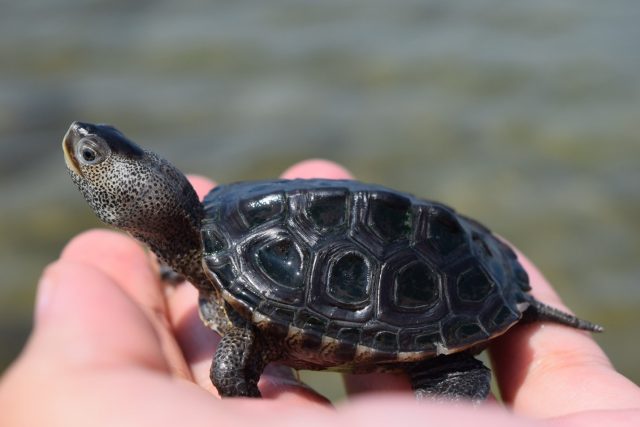Amidst the expansive estuaries of New Jersey, a critical environmental movement is underway, led by conservationist John Wnek. His mission focuses on the protection and awareness of the diamondback terrapin, a unique species of turtle that inhabits the salt marsh ecosystems from Cape Cod, Massachusetts, to the Texas coast. John Wnek’s initiatives in Southern New Jersey are pivotal, aiming not only to safeguard these creatures but also to instill a broad-based community commitment to their survival and thriving habitats.
Understanding the Diamondback Terrapin
Diamondback terrapins (Malaclemys Terrapin) are distinctive for being the only turtles in the Western Hemisphere that exclusively inhabit brackish estuarine environments. These areas, where saltwater from the sea mixes with freshwater from rivers, are vital for the ecological balance and biodiversity of the region. Terrapins play an integral role as indicators of the health of these ecosystems. Adult female terrapins are particularly noted for their nesting habits, which occur from late May through mid-July in New Jersey. They venture ashore to elevated grounds where they dig nests and lay eggs. Post-nesting, the eggs undergo an incubation period lasting between 60 and 90 days. Interestingly, the sex of the hatchlings is determined by the temperature within the nest during incubation, with warmer temperatures typically yielding a higher ratio of females. When the young terrapins hatch, they face the immediate challenge of navigating to the safety of nearby salt marshes. This journey is fraught with natural predators such as crows, raccoons, foxes, and other animals that prey on eggs and hatchlings.
The Perils Facing Diamondback Terrapins
The survival of diamondback terrapins is threatened by several factors. Naturally, they contend with predation; however, human-induced threats pose significant risks. These turtles often drown after being inadvertently caught in overnight crab pots. Additionally, the nesting drives of female terrapins sometimes lead them across roadways, where they are vulnerable to vehicle collisions. Springtime further exposes hatchlings to dangers like road traffic, curbside traps, and even storm drains, which can be lethal.
John Wnek’s Multifaceted Conservation Approach
John Wnek’s conservation strategies are as diverse as the challenges they address. His project, known affectionately as Project Terrapin, encompasses a range of initiatives designed to promote terrapin survival through education, habitat improvement, and community engagement.
- Educational Outreach: A core element of Project Terrapin is to elevate public understanding of the diamondback terrapin’s ecological role and the threats it faces. Through workshops, school programs, and community events, John and his team disseminate knowledge and foster a conservation-minded culture.
- Enhancing Nesting Sites: Sometimes called “Turtle Gardens”. Recognizing the perilous journey of nesting female terrapins, the project focuses on improving existing nesting sites and creating safer, alternative locations for egg-laying. These efforts reduce the likelihood of road mortality and increase the chances of hatchling survival.
- Modifying Fishing Practices: Collaborations with the local fishing community are crucial. By advocating for and implementing terrapin-safe modifications to crab pots, Project Terrapin aims to significantly reduce the accidental drowning of terrapins.
- Developing Rescue Protocols: A significant aspect of the initiative involves engaging the public in direct conservation actions. John Wnek’s team has developed straightforward rescue protocols that empower residents and visitors to safely assist terrapins they encounter in vulnerable situations.
How You Can Participate in Terrapin Conservation
John Wnek of New Jersey stresses that the success of terrapin conservation is heavily reliant on community participation. Everyone, from local residents to seasonal visitors, can contribute to protecting these turtles:
- Stay Vigilant: Especially during the nesting and hatching seasons, be alert for terrapins crossing roads or appearing in unusual locations such as residential yards.
- Follow Rescue Steps: If you encounter a terrapin in a dangerous spot, gently move it to safety using the prescribed methods to minimize stress and risk to the animal. Please be careful as well since moving traffic can be dangerous to terrapins and those individuals that are trying to assist them.
- Report and Engage: Notify local wildlife authorities of any terrapin sightings, and, particularly those that might be suspicious ( the illegal pet trade is a threat to terrapins as well). Engaging with conservation groups and participating in local initiatives amplifies the impact of your actions.
- Support and Volunteer: Contributions, whether through volunteer time or donations, are invaluable. Supporting local conservation efforts ensures that projects like John Wnek’s Project Terrapin can continue and expand.
A Community United for Conservation
The conservation of diamondback terrapins is more than a local issue; it’s a testament to how collective action can yield significant ecological benefits. Under the guidance of John Wnek and through the dedication of the New Jersey community including terrapin actions in southern New Jersey, the future for diamondback terrapins looks more secure thanks to.. The Wetlands Institute in Cape May, the Margate Terrapin Rescue Project, conservation work in Sea Isle and Ocean City, The Terrapin Nesting Project at Long Beach Island, The Conserve Wildlife Foundation of New Jersey, The Long Beach Township Marine Field Station, The Terrapin Conservation Initiative, and Stockton University’s Vivarium are all partners in terrapin conservation. Every effort, no matter how small, contributes to the broader goal of maintaining biodiversity and ecological health in our estuarine environments.








